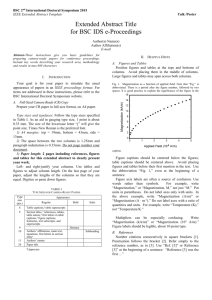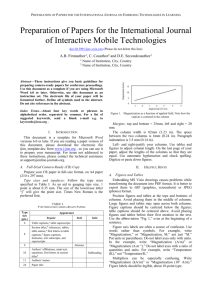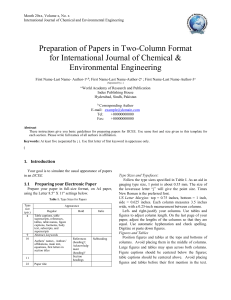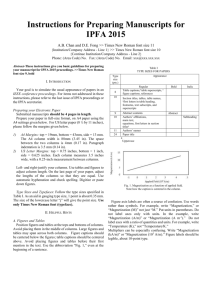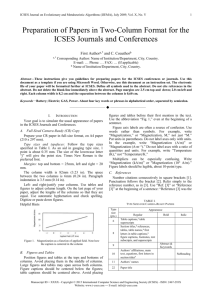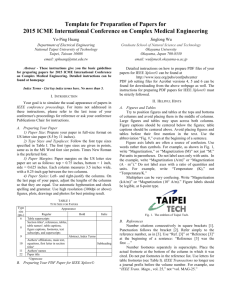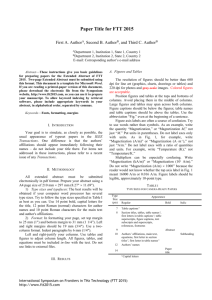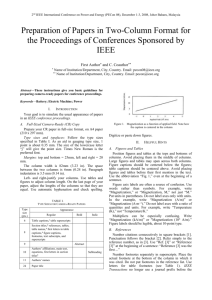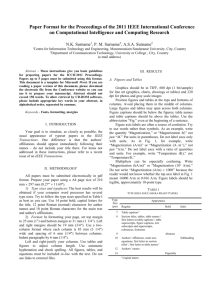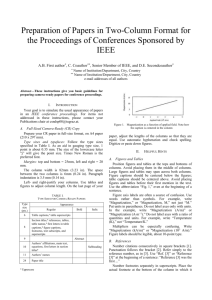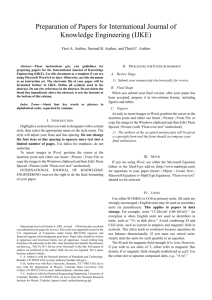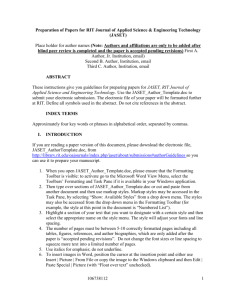Preparation of Papers in Two-Column Format
advertisement
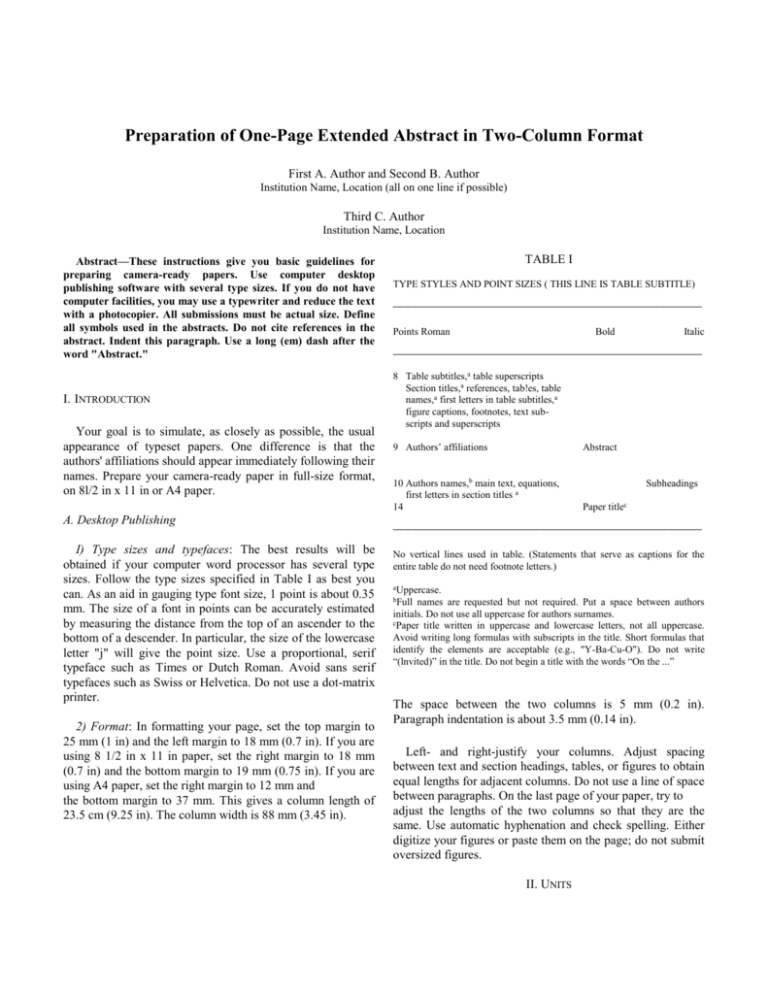
Preparation of One-Page Extended Abstract in Two-Column Format First A. Author and Second B. Author Institution Name, Location (all on one line if possible) Third C. Author Institution Name, Location Abstract—These instructions give you basic guidelines for preparing camera-ready papers. Use computer desktop publishing software with several type sizes. If you do not have computer facilities, you may use a typewriter and reduce the text with a photocopier. All submissions must be actual size. Define all symbols used in the abstracts. Do not cite references in the abstract. Indent this paragraph. Use a long (em) dash after the word "Abstract." I. INTRODUCTION Your goal is to simulate, as closely as possible, the usual appearance of typeset papers. One difference is that the authors' affiliations should appear immediately following their names. Prepare your camera-ready paper in full-size format, on 8l/2 in x 11 in or A4 paper. A. Desktop Publishing I) Type sizes and typefaces: The best results will be obtained if your computer word processor has several type sizes. Follow the type sizes specified in Table I as best you can. As an aid in gauging type font size, 1 point is about 0.35 mm. The size of a font in points can be accurately estimated by measuring the distance from the top of an ascender to the bottom of a descender. In particular, the size of the lowercase letter "j" will give the point size. Use a proportional, serif typeface such as Times or Dutch Roman. Avoid sans serif typefaces such as Swiss or Helvetica. Do not use a dot-matrix printer. 2) Format: In formatting your page, set the top margin to 25 mm (1 in) and the left margin to 18 mm (0.7 in). If you are using 8 1/2 in x 11 in paper, set the right margin to 18 mm (0.7 in) and the bottom margin to 19 mm (0.75 in). If you are using A4 paper, set the right margin to 12 mm and the bottom margin to 37 mm. This gives a column length of 23.5 cm (9.25 in). The column width is 88 mm (3.45 in). TABLE I TYPE STYLES AND POINT SIZES ( THIS LINE IS TABLE SUBTITLE) _________________________________________ Points Roman Bold Italic _________________________________________ 8 Table subtitles,a table superscripts Section titles,a references, tab!es, table names,a first letters in table subtitles,a figure captions, footnotes, text subscripts and superscripts 9 Authors’ affiliations Abstract 10 Authors names,b main text, equations, first letters in section titles a 14 Subheadings Paper titlec _________________________________________ No vertical lines used in table. (Statements that serve as captions for the entire table do not need footnote letters.) aUppercase. bFull names are requested but not required. Put a space between authors initials. Do not use all uppercase for authors surnames. cPaper title written in uppercase and lowercase letters, not all uppercase. Avoid writing long formulas with subscripts in the title. Short formulas that identify the elements are acceptable (e.g., "Y-Ba-Cu-O"). Do not write “(lnvited)” in the title. Do not begin a title with the words “On the ...” The space between the two columns is 5 mm (0.2 in). Paragraph indentation is about 3.5 mm (0.14 in). Left- and right-justify your columns. Adjust spacing between text and section headings, tables, or figures to obtain equal lengths for adjacent columns. Do not use a line of space between paragraphs. On the last page of your paper, try to adjust the lengths of the two columns so that they are the same. Use automatic hyphenation and check spelling. Either digitize your figures or paste them on the page; do not submit oversized figures. II. UNITS Use either SI (MKS) or CGS as primary units. (SI units are strongly encouraged). English units may be used as secondary units (in parentheses). An exception is when English units are used as identifiers in trade, such as ''3 1/2-in disk drive." Avoid combining SI and CGS units, such as current in amperes and magnetic field in oersteds. This often leads to confusion because equations do not balance dimensionally. If you must use mixed units, clearly state the units for each quantity that you use in an equation. III. HELPFUL HINTS A. Figures and Tables Position figures and tables at the tops and bottoms of columns. Avoid placing them in the middle of columns. Large figures and tables may span both columns. Clear photocopies are acceptable for line drawings. Place figure captions below the figures; place table captions above the tables. Avoid placing figures and tables before their first mention in the text. Use the abbreviation "Fig." even at the beginning of a sentence. Do not abbreviate "Table." Tables are numbered with Roman numerals. Figure axis labels are often a source of confusion. Use words rather than symbols. As an example, write the quantity "Magnetization," or "Magnetization, M," not just "M." Put units in parentheses. Do not label axes only with units. In the example, write "Magnetization (A/m)" or "Magnetization (A-m-1),'' not just "A/m." Do not label axes with a ratio of quantities and units. For example, write "Temperature (K)," not "Temperature/K." Multipliers can be especially confusing. Write "Magnetization (kA/m)" or "Magnetization (10 A/m)." Do not write "Magnetization (A/m) x 1000" because the reader would not know the interpretation. Figure labels should be legible, approximately 10-point type. B. References Number citations consecutively in square brackets [1]. The sentence punctuation follows the brackets [2]. Multiple references [2], [3] are each numbered with separate brackets [1]-[3]. In sentences, refer simply to the reference number, as in [3]. Do not use "Ref. [3]" or "reference [3]" except at the beginning of a sentence: "Reference [3] shows ..." Number footnotes separately in superscripts.1 Place the actual footnote at the bottom of the column in which it is cited. Do not put footnotes in the reference list. Use letters for table footnotes (see Table I). Give all authors' names in the reference list; do not use "et al. Use a space after authors' initials. Papers that have not been published, even if they have been submitted for publication, should be cited as "unpublished" [4]. Papers that have been accepted for publication should be cited as "in press" [5]. Please give affiliations and addresses for personal communications [6]. Capitalize only the first word in a paper title, expect for proper nouns and element symbols. If you are short of space, 1Footnotes should be avoided. Instead, try to integrate the footnote information into the text. Do not use a line to separate footnotes from the text. you may omit paper titles. However, paper titles are helpful to your readers and strongly recommended. For papers published in translation journals, please give the English citation first, followed by the original foreign language citation [7]. C. Abbreviations and Acronyms Define abbreviations and acronyms the first time they are used in the text, even after they have already been defined in the abstract. Abbreviations such as SI, MKS, CGS, ac, dc, and rms do not have to be defined. Abbreviations that incorporate periods should not have spaces; write "C.N.R.S.,” not "C. N. R. S." Do not use abbreviations in the title unless they are unavoidable. D. Equations Number equations consecutively with equation numbers in parentheses flush with the right margin. To make your equations more compact, you may use the solidus (/), the exp function, or appropriate exponents. Italicize Roman symbols for quantities and variables, but not Greek symbols. Use a long (en) dash rather than a hyphen for a minus sign. Use parentheses to avoid ambiguities in denominators. Be sure that the symbols in your equation have been defined before the equation appears or immediately following. Refer to "(1)," not "Eq. (1)" or "equation (1)," except at the beginning of a sentence: "Equation (1) is ..." E. Other Recommendations The Roman numerals used to number the section headings are optional. If you do use them, begin with I. I NTRODUCTION, but do not number ACKNOWLEDGMENT or REFERENCES; use letters for Subheadings. Avoid placing "orphan" section headings at the bottom of a column. Use one space after periods and colons if you are using a proportional typeface. Hyphenate complex modifiers: "zerofield-cooled magnetization." Avoid dangling participles, such as, "Using (1), the potential was calculated." [Did the potential use (1)?] Write instead, "The potential was calculated by using (1)," or "Using (1), we calculated the potential." Use a zero before decimal points: "0.25," not ".25." Use "cm3," not "cc." Indicate sample dimensions as "0.1 cm x 0.2 cm," not "0.1 x 0.2 cm2." Do not mix complete spellings and abbreviations of units: use "Wb/m2" or "webers per square meter," not "webers/m2." A parenthetical statement at the end of a sentence is punctuated outside of the closing parenthesis (like this). (A parenthetical sentence is punctuated within the parentheses.) In American English, periods and commas are within quotation marks, like "this period.” Other punctuation is "outside"! It is acceptable to use British punctuation and spelling variations. Note that the preferred British spelling of "magnetization" is with a "z," not an "s." If your native language is not English, please get a native English-speaking colleague to proofread your paper. IV. SOME COMMON MlSTAKES The word "data" is plural, not singular. The subscript for the permeability of vacuum 0 is zero, not a lowercase letter "o." A graph within a graph is an "inset," not an "insert." The word "alternatively” is preferred to the word "alternately" (unless you really mean something that alternates). Do not use the word "essentially” to mean "approximately or "effectively." Be aware of the different meanings of the homophones "affect" and "effect," "complement" and "compliment," "discreet" and "discrete," "principal" and "principle." Do not confuse "imply' and "infer." The prefix "non" is not a word; it should be joined to the word it modifies, usually without a hyphen. There is no period after the "et" in the Latin abbreviation "et al." The abbreviation "i.e." means "that is," and the abbreviation "e.g." means "for example." An excellent style manual and source of information for science writers is [8]. V. EDITORIAL POLICY The submitting author is responsible for obtaining agreement of all coauthors and any consent required from sponsors before submitting the Extended Abstract. APPENDIXES Appendixes, if needed, appear before the acknowledgment. The reference list is the last section of the paper; do not put figures or appendixes after the references. ACKNOWLEDGMENT The preferred spelling of the word "acknowledgment" in American English is without an "e" after the "g." Use the singular heading even if you have multiple acknowledgments. Avoid the stilted expression, "One of us (S.B.A.) thanks ..." Instead, write "S.B.A. thanks ..." REFERENCES [l] G. Eason, B. Noble, and I. N. Sneddon, "On certain integrals of Lipschitz-Hankel type involving products of Bessel functions,” Phil. Trans. Roy. Soc. London, vol. A247, pp. 529-551, April 1955. [2] J. Clerk Maxwell, A Treatise on Electricity and Magnetism, 3rd ed., vol. 2. Oxford:, 1892, pp. 68-73. [3l I. S. Jacobs and C. P. Bean, “Fine particles, thin films and exchange anisotropy,” in Magnetism, vol. III, G. T. Rado and H. Suhl, Eds. New York: Academic, 1963, pp. 271-350. [4] K. Elissa, "Title of paper if known,” unpublished. [5] R. Nicole, "Title of paper with only first word capitalized,” J. Name Stand. Abbr., in press. [6] C. J. Kaufman, Rocky Mountain Research Laboratories, Boulder, CO., personal communication, 1992. [7] Y. Yorozu, M. Hirano, K Oka, and Y. Tagawa, Electron spectroscopy studies on magneto-optical media and plastic substrate interface,” IEEE Transl. J. Magn. Jpn., vol. 2, pp. 740-741, August 1987 [Dig. 9th Annual Conf. Magn. Jpn., p. 301, 1982]. [8] M. Young, The Technical Writers Handbook.. Mill Valley, CA.: University Science, 1989.
